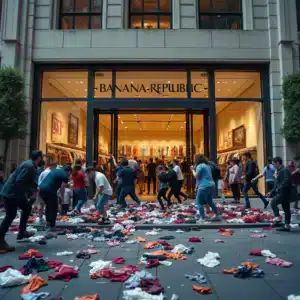4 Ways to Determine if Old Navy Is Fast Fashion
Old Navy Is Fast Fashion
In today’s world of fast-paced trends, it’s becoming harder to distinguish between brands that focus on quality and those that emphasize quantity. One brand that often sparks this debate is Old Navy. You may have asked yourself, “Is Old Navy fast fashion?” as you browse through their affordable, trendy clothing. If you’ve ever wondered about the environmental impact or the ethics behind the clothes you wear, understanding the role that Old Navy plays in the fashion industry is crucial.
This article will explore four key ways to determine if Old Navy is fast fashion, helping you make informed choices about your wardrobe and shopping habits. By the end, you’ll have a clear understanding of whether Old Navy fits the fast fashion model and what that means for you as a consumer.
Table of Contents
What is Fast Fashion?
Before diving into whether Old Navy is fast fashion, it’s important to first understand what fast fashion actually means. Fast fashion refers to the practice of rapidly producing clothing based on the latest trends, making them available to consumers at affordable prices. These brands typically focus on getting new styles into stores as quickly as possible, often at the expense of quality, ethics, and environmental sustainability.
Fast fashion encourages overconsumption, pushing consumers to purchase clothes they might not need, only to discard them quickly after trends shift. This business model has led to serious environmental consequences, including textile waste, pollution, and the exploitation of low-wage labor in developing countries.

1. Quick Turnaround of Trends at Old Navy
A hallmark of fast fashion is the ability to quickly respond to the latest fashion trends, turning runway looks into affordable, mass-produced styles that are available to you within weeks. One of the easiest ways to determine if Old Navy is fast fashion is by looking at how quickly they introduce new collections.
Key Points to Consider:
- Frequent New Collections: Old Navy releases new collections regularly, sometimes even multiple times per month. These collections often reflect the most current fashion trends, designed to appeal to shoppers looking for the latest styles at affordable prices.
- Trend-Driven Pieces: Many of the items sold at Old Navy are heavily trend-based. From floral prints to graphic tees, Old Navy regularly adapts its inventory to reflect the hottest trends. While this can be exciting for shoppers, it’s a clear indicator of fast fashion.
- Limited Lifespan of Styles: If you’ve noticed that certain items at Old Navy only seem to stay in stores for a limited time before being replaced by new stock, that’s a key sign of fast fashion. Brands that focus on quickly cycling out inventory do so to create urgency and encourage customers to purchase before the items are gone.
Why It Matters:
When brands push out new trends so quickly, it leads to a “buy now or miss out” mentality, making it harder to think critically about whether you truly need the item. The rapid turnover of trends can also contribute to overproduction and unnecessary waste, both of which are significant issues in the fast fashion industry.

2. Low Prices and Frequent Discounts
Another hallmark of fast fashion is the emphasis on affordable prices and frequent discounts. Fast fashion companies, including Old Navy, are known for offering trendy clothing at very low prices. This is appealing to budget-conscious consumers, but it often comes at the cost of quality and sustainability.
Key Points to Consider:
- Affordable Pricing: Old Navy’s prices are often lower than many other retail brands. For example, a basic t-shirt might be priced at $10 or less, while a pair of jeans could be as low as $25. This affordability is one of the reasons Old Navy is so popular, especially for families and budget shoppers.
- Frequent Sales and Promotions: Old Navy frequently holds sales, offering significant discounts on already affordable clothing. This can encourage impulse buying, making it easy for you to accumulate items you don’t necessarily need. While sales might seem like a great deal in the moment, they are often a tactic used by fast fashion brands to move large quantities of merchandise quickly.
- Impact on Quality: The low price point can be a red flag when it comes to the quality of materials used. Fast fashion brands often use cheaper, lower-quality fabrics to produce their clothing at lower costs. This can result in items that wear out quickly, encouraging consumers to buy more often, which fuels the cycle of fast fashion.
Why It Matters:
While saving money is great, the impact of purchasing cheap, low-quality items can be long-lasting. Not only do these pieces often have a short lifespan, but the demand for inexpensive clothing also fuels harmful practices in the fashion industry, including the exploitation of workers and unsustainable manufacturing processes.
3. Production Practices and Supply Chain Transparency
Transparency is one area where fast fashion brands like Old Navy tend to fall short. The fast fashion business model thrives on secrecy, keeping details about where and how clothes are made largely hidden from consumers. Understanding a brand’s supply chain can provide valuable insight into its commitment to sustainability and ethical practices.
Key Points to Consider:
- Lack of Supply Chain Transparency: Old Navy, like many fast fashion brands, provides very little information about its supply chain. It is difficult to find details about where their clothing is made and under what conditions. This lack of transparency is a key indicator that Old Navy might be engaging in fast fashion practices.
- Production Locations: Most fast fashion brands, including Old Navy, source their production from countries with lower labor costs, often in regions with weak labor laws. While Old Navy may promote its commitment to ethical labor practices, the lack of transparency raises concerns about working conditions in some of these factories.
- Sustainability and Certification: If a brand is truly committed to sustainable practices, it will openly share its certifications and sustainability reports. Old Navy doesn’t have widespread certifications from organizations like Fair Trade or GOTS (Global Organic Textile Standard), which are commonly associated with brands that prioritize ethical practices.
Why It Matters:
Without transparency, it’s nearly impossible to know how your clothing is being made or whether workers are treated fairly. By purchasing from brands that lack supply chain transparency, you could unknowingly be supporting exploitative labor practices or environmentally damaging production processes.

4. Environmental Impact: Sustainability and Waste
The environmental toll of fast fashion cannot be overstated. The sheer volume of clothing produced by fast fashion brands like Old Navy contributes to massive amounts of waste, pollution, and the depletion of natural resources. Let’s take a closer look at Old Navy’s environmental impact and whether they’re doing anything to address sustainability.
Key Points to Consider:
- Synthetic Fabrics: Many of Old Navy’s clothes are made from synthetic fabrics like polyester, which are not biodegradable. These materials contribute to microplastic pollution when washed and do not decompose over time, adding to landfill waste.
- Overproduction: Old Navy, like other fast fashion brands, is often criticized for overproducing clothing to meet the demand for cheap, trendy pieces. This leads to excess inventory that ends up in landfills or is burned, further contributing to waste.
- Sustainability Efforts: While Old Navy has launched a few eco-friendly collections in the past, their efforts are relatively minimal compared to other more sustainability-focused brands. For example, they have introduced some clothing made from recycled materials, but the majority of their inventory still follows traditional fast fashion practices.
Why It Matters:
As consumers, it’s important to consider the environmental impact of the products we buy. Opting for brands that prioritize sustainability can help reduce the harmful effects of fast fashion, such as textile waste and pollution. Supporting more eco-conscious brands can drive change in the industry toward more responsible production practices.
Conclusion: Is Old Navy Fast Fashion?
Based on these four key factors—rapid trend turnover, affordable pricing, lack of transparency in production, and environmental impact—it’s clear that Old Navy shares many characteristics of fast fashion. The brand focuses on quickly responding to the latest trends, providing affordable options for shoppers, and frequently offering sales to move merchandise quickly. While they have taken some steps toward sustainability, such as introducing eco-friendly collections, their overall practices align more with fast fashion than with sustainable, ethical production.
As a consumer, it’s up to you to decide whether Old Navy’s low prices and trendy designs outweigh the environmental and ethical concerns that come with fast fashion. By making informed choices, you can better align your purchasing habits with your values and contribute to a more sustainable and ethical fashion industry.
If you’re ready to make more conscious shopping decisions, consider exploring sustainable fashion brands that prioritize transparency, ethical labor practices, and environmental sustainability. Every small change you make in your shopping habits can have a big impact on the world around you. Start by being more mindful of where your clothes come from, and take steps toward building a more sustainable wardrobe today.













Add comment